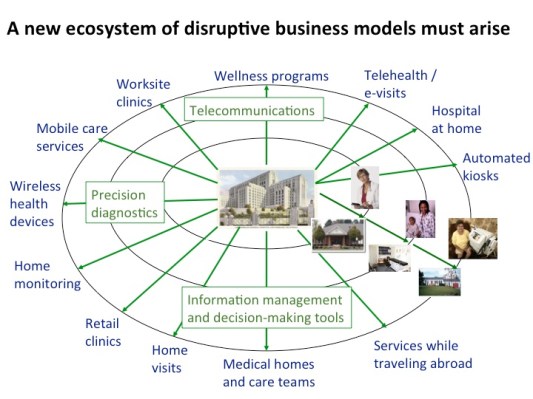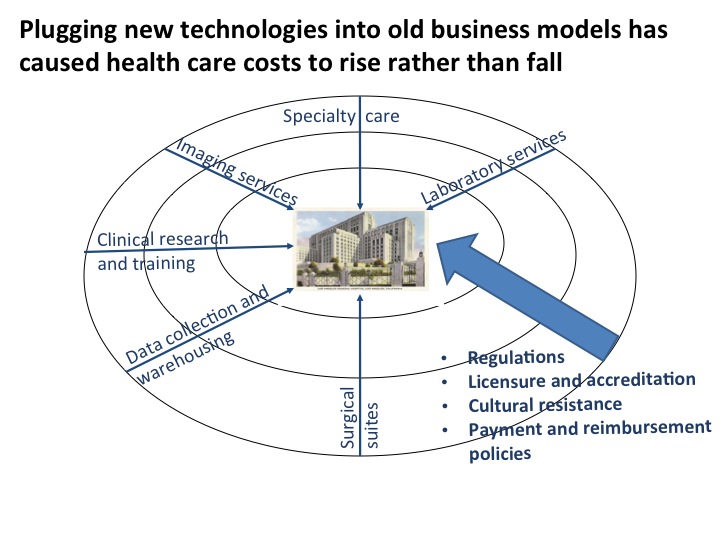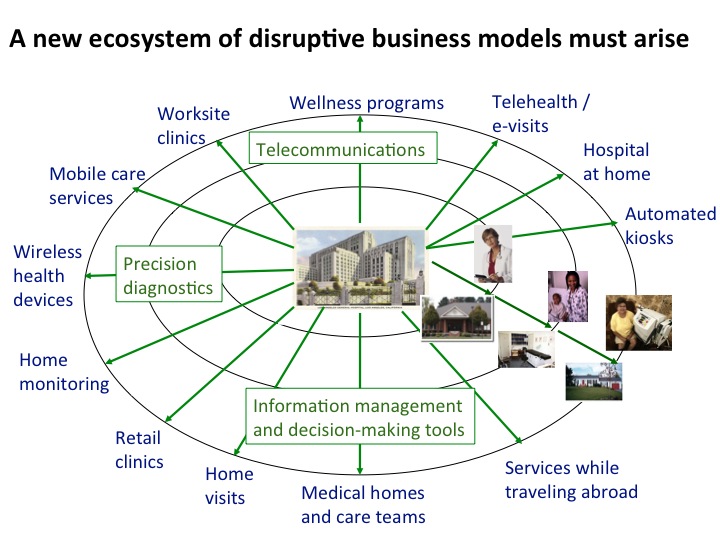Editor’s note: This guest post was written by Dave Chase, the CEO of Avado.com, a patient portal & relationship management company that was a TechCrunch Disrupt finalist. Previously he was a management consultant for Accenture’s healthcare practice and founder of Microsoft’s Health platform business. You can follow him on Twitter @chasedave.
Images are courtesy of Jason Hwang, M.D., M.B.A. Executive Director, Healthcare of the Innosight Institute and co-author of The Innovator’s Prescription.
In the New Yorker, Dr. Atul Gawande outlined how, at the turn of the 20th century, more than forty per cent of household income went to paying for food and food production consumed nearly half the workforce. Starting in Texas, a wide array of new methods of food production were tested. Long story short, food now accounts for 8% of household budgets and 2% of the workforce. As a wide array of small innovations ultimately led to the transformation of farming, so too is a rapidly building wave of innovative new care and payment models leading to similar breakthroughs in healthcare. I call this Nimble Medicine.
Traditionally, attempting a new care or payment model meant long planning and development cycles. The cost and complexity of testing new models prevented many from being tried. Even today, the leading HealthIT vendor is known to charge $100 million and up for its software. Amazingly, they require three months of training before they even let people use the software. This is a vestige of the “do more, bill more” model of reimbursement particularly given that healthcare is a supply-driven market (e.g., MDs who own a stake in imaging equipment order scans at three times the rate of MDs who don’t). Spending nine figures doesn’t sound so bad when you have capital projects planned in excess of $1 Billion. Perhaps we should refer to the legacy model as the “build more, do more, bill more” model. Any health analyst will tell you that the cure for healthcare’s hyperinflation is NOT building more healthcare facilities. It’s as if a fire department argued that the way to solve a wave of structural fires was to buy more fire fighting equipment. Yes, that might help, however there’s a much more cost-effective approach such as having buildings inspected for fire prevention capabilities.
In their book, The Innovator’s Prescription, Clayton Christensen and Dr. Jason Hwang point out how applying technology into old business models has only raised costs.
In contrast, disruptive innovators such as WhiteGlove Health and Qliance rethought the care delivery and payment models from the ground up. Their results have been impressive. For example, Qliance has Net Promoter Scores higher than Google or Apple, while reducing the direct costs of healthcare (i.e., their service coupled with a high deductible wrap-around policy) 20-40%. More impressively, they have reduced the most expensive downstream costs (surgical, specialist and emergency visits) 40-80%. Likewise, WhiteGlove Health already has 500,000 members and has more 5-star reviews on CitySearch than any other organization in the country. In WhiteGlove’s S-1 filing, they highlight the importance of proprietary software they have developed to give them a cost and consumer experience advantage.
The next wave of disruptive innovators are taking advantage of second-mover advantage as the wave of healthtech startups provide them off-the-shelf software that is an order of magnitude less investment than the first wave of innovators. It’s a couple orders of magnitude less expensive than legacy HealthIT. More importantly for the innovators is the speed that they can not only stand up the new technology but also easily iterate based on real world experience. Rather than months or years, it’s hours or days. This is a key component of Nimble Medicine.
Consider the following scenarios: [Disclosure, my company, provides some of the technology components underlying these models which is why I have visibility into their strategy.]
- arriveMD has taken the lean practice model to an extreme by closing a bricks and mortar clinic and replacing it with a clinic on wheels. Their founder, Dr. Craig Koniver, visits patients at their home or workplace. It only took a couple weeks to put the technology into practice while running his practice, closing his stationary clinic, and outfitting his clinic on wheels.
- MedLion (aka The Most Important Organization in Silicon Valley No One Has Heard About) has created a fast-growing Direct Primary Care model with minimal capital investment. So far in 2012, they are opening clinics at the rate of one per week. They’ve done this with a mix of a creative business model and enabling technology that is well under 5% of the cost of what their competition has spent.
- A company that is providing emergency physicians to hospitals has found that many individuals are using the emergency department as their primary care facility. This is because these individuals aren’t able to access a regular primary care provider. Unfortunately, many of them are unable to pay the high fees common in an ER. Rather than simply sending them to collections, they are setting up an affordable alternative outside of the ER for non-emergent care. The technology setup takes less than a week to enable this new line of business. They’ve taken a lesson from wireless carriers who realize that more affordable packages can address a market need yet still be profitable.
- Sites such as 2nd.md have created virtual second opinion or e-consult marketplaces. Rather than flying from Alaska to San Francisco to get a critical second opinion or consultation, the individual and their family can save time and money through a virtual encounter. In response, some physicians are realizing that they can set something up directly without having to pay a 3rd party intermediary. Their technology need is essentially a light-weight (and low cost) system that allows intake of patient information (medical history, lab results, etc.), a virtual visit (e.g., using software from a company like Revation) and then follow-up documentation. The entire technology implementation doesn’t take more than a couple of days. This has been applied in disciplines ranging from oncology to orthopedics to pediatrics and more.
- Even established organizations such as Catholic Health Partners are becoming more nimble. For example, a when drug gets taken off the market for safety issues, they can immediately identify the subgroup of patients currently on the drug for outreach, while simultaneously removing the drug from order preference lists and order sets, substituting with appropriate alternative medications. At one time this took days and now it takes just hours.
For those of us in the technology industry, there’s striking parallels with what has happened in technology where centralization was followed by decentralization. For providers, lessons can be drawn regarding how some organizations were able to make the transition from one generation to the next while many others faded from the landscape. The graphic below depicts the transition from the slide rule to the mainframe and then back out to mobile devices.
In an earlier piece (Healthcare Field of Dreams In Idaho: Health System Opens Innovation Center), I highlighted an innovation group that is building the next “hospital” – a hospital without walls. Unlike a massive capital project necessary to build a traditional hospital, I expect that new “wings” of the virtual hospital will get built via a series of smaller projects. They have hired entrepreneurial people to bring the agility necessary in this new approach. This is a great example of Nimble Medicine.
Related articles:
Money Ball for Medicine – Business Models for Healthcare
Healthcare Disruption: Providers Are Making Newspaper Industry Mistakes



